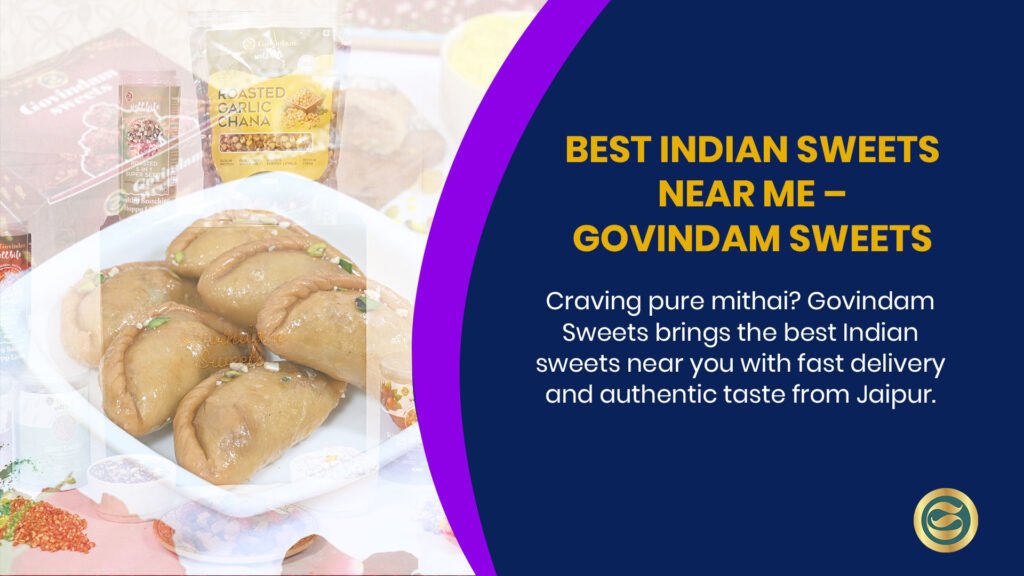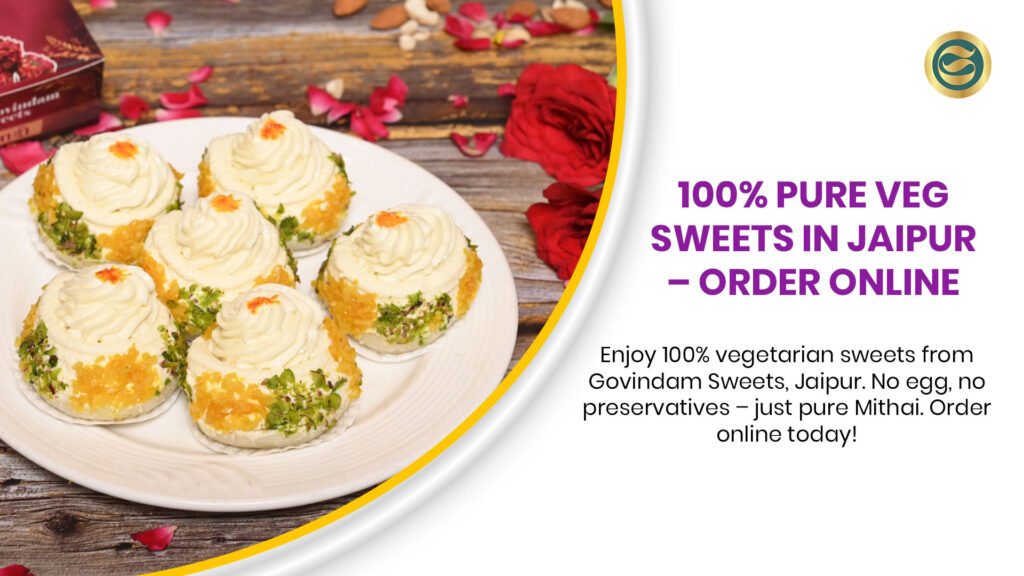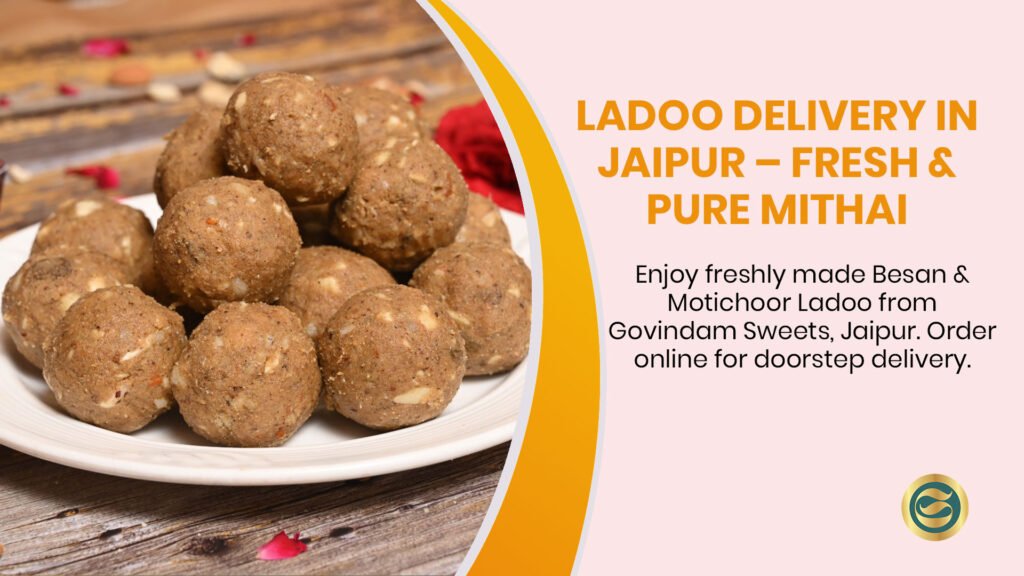Traditional Indian Sweets – Govindam Jaipur

Explore India’s rich confectionery heritage through Govindam’s traditional Indian sweets. Handcrafted using centuries-old recipes and premium ingredients, these authentic delicacies showcase regional flavors from Rajasthan to Bengal. Experience the perfect balance of textures, aromas, and tastes that have delighted generations and defined celebratory moments across India.
The Rich Heritage of Traditional Indian Sweets
India’s confectionery tradition spans thousands of years, with sweetmeats playing essential roles in celebrations, religious ceremonies, and daily life. Traditional Indian sweets, known as mithai, represent one of the world’s most diverse and sophisticated confectionery traditions. Each region has developed distinctive specialties reflecting local ingredients, cultural influences, and historical developments.
Govindam Sweets honors this rich heritage through meticulous preservation of traditional recipes and techniques. Their master confectioners, known as halwais, create authentic sweets using methods passed down through generations. This commitment to tradition ensures that each bite connects you to India’s remarkable culinary history – a living heritage that continues evolving while maintaining its essential character.
Regional Diversity in Traditional Indian Sweets
Rajasthani Sweet Traditions: Desert Ingenuity
Rajasthan’s sweet-making tradition reflects remarkable ingenuity in creating luxurious confections despite limited ingredients in this arid region. The state’s royal heritage influenced its sweet development, with court kitchens creating elaborate delicacies that showcased wealth and refinement. Today, these traditional Indian sweets remain symbols of Rajasthani hospitality and celebration.
Signature Rajasthani specialties include Ghewar, the intricate honeycomb-textured disc that reaches peak popularity during monsoon and Teej festivals. Mawa Kachori demonstrates Rajasthan’s creative approach by transforming a typically savory snack into a sweet delicacy filled with rich mawa (reduced milk solids) and dried fruits. Energy-rich creations like Balwan Laddu reflect the practical need for sustaining nourishment in desert conditions.
Bengali Sweet Sophistication: Eastern Elegance
Eastern India, particularly Bengal, developed a distinctive sweet tradition centered around chhana (fresh curdled milk cheese). These traditional Indian sweets feature more delicate textures and subtle flavors compared to the ghee-rich confections of western India. Bengali sweet-making represents one of India’s most refined culinary arts, with techniques requiring exceptional skill and precision.
Bengali Sweets like rasgulla, sandesh, and chamcham showcase the region’s mastery of milk-based confections. Their subtle flavoring often incorporates delicate essences like rose water, saffron, or cardamom rather than bolder spice mixtures. These eastern specialties provide perfect counterpoints to richer regional varieties, creating balanced traditional sweet assortments.
North Indian Classics: Celebratory Standards
Northern India’s sweet tradition features many of the confections most widely recognized as traditional Indian sweets. These include Gulab Jamun, Jalebi, and various barfis that have become standard celebratory offerings throughout the country. The northern tradition balances techniques from both eastern and western regions while adding distinctive touches like the use of khoya (milk reduced to solid form).
Signature northern creations include the silver-adorned Kaju Katli, creamy Rasmalai, and festive Imarti. These beloved classics appear at virtually all major celebrations and frequently feature as everyday treats as well. Their widespread popularity makes them essential components of any comprehensive traditional Indian sweet collection.
Southern Specialties: Distinctive Ingredients
Southern India’s distinct sweet tradition incorporates ingredients less common in northern regions, particularly coconut, jaggery (palm sugar), and rice flour. These traditional Indian sweets often feature unique preparation methods, including steaming techniques rarely seen in northern confectionery. The southern tradition also embraces contrasting flavor profiles, frequently combining sweet and savory elements.
Distinctive southern creations include Mysore Pak, Adhirasam, and various Payasam varieties. While less represented in northern sweet shops, these southern specialties offer fascinating glimpses into regional diversity and demonstrate the incredible breadth of India’s sweet-making heritage.
Key Ingredients in Traditional Indian Sweets
The Foundation: Milk and Its Derivatives
Milk forms the foundation of most traditional Indian sweets, appearing in various transformed states that showcase India’s sophisticated understanding of dairy chemistry. These transformations include:
- Khoya/Mawa: Milk reduced to solid form through slow evaporation
- Chhana: Fresh curdled milk cheese used primarily in eastern sweets
- Rabri: Thickened, sweetened milk with layers of cream
- Ghee: Clarified butter that provides distinctive richness
Govindam Sweets creates these dairy foundations fresh daily rather than using commercial versions. This labor-intensive approach results in superior flavor and texture impossible to achieve with pre-made ingredients. Their commitment to fresh dairy ensures traditional sweets maintain their authentic character and exceptional quality.
Sweeteners: Beyond Simple Sugar
Traditional Indian sweets incorporate diverse sweeteners that contribute distinctive flavor profiles beyond mere sweetness. While refined sugar appears in many recipes, traditional options include:
- Jaggery (Gur): Unrefined cane or palm sugar with complex mineral notes
- Honey: Used in select traditional recipes, particularly those with medicinal roots
- Date Palm Sugar: Featured in eastern specialties with caramel-like complexity
- Raw Sugar (Khand): Less processed sugar with molasses content intact
These traditional sweeteners add depth and complexity while connecting recipes to regional agricultural practices. The interplay between sweetener choice and other ingredients demonstrates the sophisticated balance achieved in traditional Indian confectionery.
Flours and Grains: Diverse Foundations
Various flours and grains provide structure for many traditional Indian sweets, with regional preferences creating distinctive textural characteristics. Common foundations include:
- Besan (Gram Flour): The base for ladoos and several Rajasthani specialties
- Rice Flour: Prominent in southern preparations and select northern specialties
- Wheat Flour: Featured in ghewar, imarti, and various festival-specific creations
- Semolina (Suji): Creates distinctive texture in halwas and certain regional specialties
The treatment of these foundations—roasting, steaming, or frying—dramatically influences the final product’s character. Master confectioners understand exactly how to manipulate these ingredients to achieve ideal texture and flavor development.
Nuts and Embellishments: Luxury Elements
Premium traditional Indian sweets incorporate generous quantities of nuts, dried fruits, and aromatic ingredients that elevate the experience while signifying celebration and abundance. Common luxury additions include:
- Pistachios, almonds, and cashews both within and garnishing sweets
- Saffron for distinctive color and aromatic complexity
- Cardamom, the signature spice of Indian confectionery
- Rose water and kewra (screwpine) essence for floral dimension
- Silver or gold leaf (varq) for ceremonial presentations
Chogni Laddu exemplifies this tradition of abundance, featuring lavish quantities of nuts and dried fruits. These luxury elements transform basic sweets into celebratory offerings appropriate for significant occasions.
The Artistry of Traditional Sweet Making
Specialized Techniques and Tools
Creating authentic traditional Indian sweets requires specialized techniques and tools that have evolved specifically for these unique confections. Many of these methods demand considerable physical skill and stamina, particularly the muscle memory needed for:
- Continuous stirring of milk for hours to create perfect khoya
- Stretching and folding sugar syrups to develop specific crystalline structures
- Hand-shaping delicate forms that maintain consistent size and appearance
- Temperature control without modern measurement tools
Master confectioners develop these skills through years of apprenticeship and practice. Their expertise cannot be replicated by machines, making traditional sweet-making one of India’s most impressive living crafts.
Regional Production Methods
Different regions have developed specific production techniques that define their traditional Indian sweets. These include:
- The precise pouring technique required for ghewar’s honeycomb structure
- Eastern India’s delicate handling of fresh chhana for optimal texture
- North India’s sugar syrup consistency gradations for different soaked sweets
- The art of sugar thread management for intricate decorative elements
Govindam’s artisans master multiple regional techniques, allowing them to create authentic versions of diverse traditional sweets rather than regional approximations. This comprehensive technical knowledge distinguishes premium sweet makers from those with more limited regional expertise.
Seasonal Adaptations and Considerations
Traditional Indian sweet production adapts to seasonal variations in temperature, humidity, and ingredient quality. These adaptations include:
- Adjusted cooking times and temperatures based on ambient conditions
- Seasonal variations in milk treatment based on its changing composition
- Modified sugar concentrations responding to atmospheric moisture levels
- Ingredient selection focused on seasonal peaks in quality and availability
These subtle seasonal adjustments ensure consistent quality despite changing conditions. The most skilled confectioners make these modifications instinctively, maintaining the essential character of traditional sweets throughout the year.
Cultural Significance of Traditional Indian Sweets
Religious and Ceremonial Connections
Traditional Indian sweets play essential roles in religious observances across faiths. Many varieties have specific ceremonial significance, including:
- Modak for Ganesh Chaturthi celebrations
- Gujiya during Holi festivals
- Special ladoo varieties for temple offerings (prasad)
- Specific mithai for different life-cycle ceremonies
The preparation of these ceremonial sweets often incorporates ritual elements that connect confectionery to spiritual practice. This sacred dimension adds profound cultural significance beyond mere culinary enjoyment.
Regional Festival Celebrations
Each region celebrates festivals with specific traditional Indian sweets that embody local cultural identity. These festival connections include:
- Ghewar during Teej celebrations in Rajasthan
- Sandesh varieties for Durga Puja in Bengal
- Puran Poli for Maharashtrian harvest festivals
- Region-specific Diwali specialties across India
These festival associations create annual cycles of anticipation and celebration centered around beloved seasonal specialties. The appearance of these traditional sweets marks time and reinforces cultural continuity across generations.
Life Milestone Celebrations
Traditional Indian sweets mark significant life events across communities, with specific varieties associated with:
- Birth announcements and naming ceremonies
- Wedding functions and marriage celebrations
- Housewarming and new beginnings
- Academic and professional achievements
These sweet-centered celebrations create emotional associations that last lifetimes. The presence of particular traditional sweets instantly evokes these significant moments, creating powerful connections between confectionery and personal history.
Experiencing Traditional Indian Sweets Today
Finding Authentic Quality
Identifying truly authentic traditional Indian sweets requires attention to key quality indicators:
- Natural coloration without artificial brightness
- Appropriate richness without excessive oiliness
- Fresh aroma featuring ghee, cardamom, and saffron rather than preservatives
- Regional character maintained in specific varieties
- Handcrafted appearance rather than machine uniformity
Govindam Sweets exemplifies these quality markers through their commitment to traditional preparation methods. Their transparent production processes build trust while educating customers about authentic characteristics that distinguish premium traditional sweets.
Modern Adaptations While Preserving Tradition
While honoring tradition, the best sweet makers thoughtfully incorporate selected modern elements that enhance quality without compromising authenticity. These adaptations include:
- Improved hygiene protocols that maintain food safety
- Packaging innovations that extend freshness without preservatives
- Subtle recipe refinements that eliminate unnecessary processing
- Nutritional considerations that respond to contemporary health awareness
These careful adaptations ensure traditional Indian sweets remain relevant to modern consumers while preserving their essential character. The balance between innovation and tradition distinguishes thoughtful evolution from compromised authenticity.
Creating Balanced Sweet Assortments
Experienced sweet connoisseurs create balanced assortments that showcase the diversity of traditional Indian sweets. Effective combinations include:
- Contrasting textures from crisp to soft to chewy
- Varied flavor profiles from delicate to robust
- Representation of multiple regional traditions
- Mix of dairy-based, flour-based, and nut-based varieties
For comprehensive tastings, consider pairing sweet selections with appropriate savory counterpoints. Traditional snacks like Pyaz Kachori, Namkeen, and Samosa provide perfect contrasts that prevent palate fatigue while showcasing the full spectrum of Indian snack traditions.
Perfect Occasions for Traditional Sweets
While traditional Indian sweets feature prominently at festivals and ceremonies, they enhance numerous everyday occasions, including:
- Business meetings and professional gatherings
- Houseguest welcomes and hospitality offerings
- Family gatherings and informal celebrations
- Personal treats and simple indulgences
The versatility of traditional sweets makes them appropriate for virtually any occasion requiring a touch of sweetness. Their cultural resonance adds meaningful dimension to even casual sharing moments.
Preserving Sweet Traditions for Future Generations
Learning Traditional Sweet Making
Interest in traditional culinary arts continues growing as people seek connections to cultural heritage. Learning traditional Indian sweet making offers particularly rich rewards, whether through:
- Formal cooking classes focusing on specific varieties
- Apprenticeship opportunities with established confectioners
- Family knowledge transmission across generations
- Detailed cookbooks and educational resources
These learning pathways keep traditional techniques alive while creating new generations of knowledgeable consumers who appreciate authentic quality. The hands-on experience of making traditional sweets deepens appreciation for the remarkable skill involved.
Business Models Sustaining Tradition
Sustainable business models ensure traditional sweet-making remains economically viable despite its labor-intensive nature. Options like Own a Franchisee Business with established brands provide structured approaches to traditional sweet commerce, balancing authenticity with economic sustainability.
These models create career opportunities for skilled artisans while making traditional sweets financially accessible to broad consumer segments. The success of these businesses demonstrates the continuing relevance and appeal of traditional Indian confectionery in contemporary markets.
Documentation and Cultural Preservation
Formal documentation preserves traditional knowledge that might otherwise disappear as older generations pass. Key preservation efforts include:
- Recording regional variations with specific technique details
- Documenting cultural and historical connections
- Preserving agricultural heritage related to specific ingredients
- Recognizing master artisans and their distinctive contributions
These preservation efforts ensure that traditional Indian sweet knowledge remains accessible for future generations, whether as practical production guidance or cultural heritage information.
Global Appreciation for Traditional Indian Sweets
International Recognition and Adoption
Traditional Indian sweets increasingly receive international recognition as sophisticated confections worthy of global culinary attention. This appreciation appears through:
- Inclusion in international culinary education
- Recognition in global food media and competitions
- Integration into cross-cultural culinary innovations
- Availability through specialty retailers worldwide
Global Shipping options now make authentic traditional sweets accessible to international customers, expanding appreciation beyond India’s borders. This worldwide availability introduces these remarkable confections to diverse audiences who might otherwise never experience authentic Indian mithai.
Culinary Tourism Centered Around Sweets
Culinary tourism increasingly includes traditional sweet exploration, with visitors seeking:
- Regional specialty tastings and comparisons
- Sweet-making demonstrations and workshops
- Historical context for distinctive varieties
- Direct interaction with master confectioners
These sweet-centered experiences create meaningful connections between visitors and local culture, offering accessible entry points into India’s rich culinary heritage through universally appealing confections.
Frequently Asked Questions
What makes traditional Indian sweets different from Western desserts?
Traditional Indian sweets differ fundamentally from Western desserts in several key ways. They typically contain no eggs or leavening agents and rarely involve baking. Instead, they showcase techniques like milk reduction, sugar syruping, and frying that create distinctive textures. Traditional Indian sweets also feature spice elements like cardamom and saffron that rarely appear in Western desserts, creating completely different flavor profiles. Perhaps most significantly, they occupy different cultural positions, frequently appearing as standalone treats rather than meal conclusions.
How long do traditional Indian sweets stay fresh?
Traditional Indian sweets without preservatives have varying shelf lives based on their ingredients and preparation methods. Dry varieties like besan ladoo typically remain fresh for 10-14 days when properly stored, while milk-based items generally last 3-5 days. Items with high moisture content like rasgulla require refrigeration and consumption within 2-3 days for optimal experience. For maximum enjoyment, consume sweets within their recommended timeframes rather than seeking extended shelf life, which typically requires quality compromises. Govindam Sweets provides specific freshness guidance for each variety.
Are traditional Indian sweets suitable for vegetarians?
Yes, most traditional Indian sweets are naturally vegetarian, containing no egg or animal-derived ingredients. The primary ingredients—milk, sugar, flours, nuts, and ghee—are all vegetarian. Some very strict vegetarians might question the source of rennet used in milk curdling for cheese-based sweets, but most established sweet makers use vegetarian curdling agents. Quality shops can confirm their specific preparation methods for customers with strict dietary requirements.
What’s the proper way to serve traditional Indian sweets?
For authentic presentation, serve traditional Indian sweets at room temperature (removing refrigerated items 30-60 minutes before serving) on silver or brass plates. Traditional serving includes small portions of multiple varieties rather than large quantities of a single type. Complement sweets with masala chai or filter coffee for traditional pairing. For formal occasions, present sweets on decorative plates, often with silver or gold accents that honor their ceremonial significance.
Can traditional Indian sweets accommodate dietary restrictions?
Many traditional Indian sweets can be adapted for various dietary requirements while maintaining authentic flavors. Sugar-free or reduced-sugar versions use natural sweeteners like stevia or monk fruit. Some varieties can be prepared with alternative milks for lactose-sensitive individuals, though texture differences will occur. Certain regional varieties like those from southern India are naturally gluten-free. For specific dietary needs, consult with quality sweet makers who can recommend suitable traditional options or create appropriate adaptations.
Conclusion: A Living Heritage Worth Celebrating
Traditional Indian sweets represent one of the world’s most sophisticated and diverse confectionery traditions—a living heritage that continues evolving while maintaining deep cultural roots. Each sweet tells a story of regional identity, historical development, and cultural significance that transcends mere indulgence. The remarkable techniques and ingredients showcase India’s culinary ingenuity across centuries of refinement.
Whether celebrating special occasions, observing cultural traditions, or simply enjoying daily moments of sweetness, traditional Indian mithai adds meaningful dimension to life’s experiences. Their continued relevance in contemporary society demonstrates their enduring appeal and cultural importance beyond passing food trends.
Experience the authentic flavors and textures of India’s sweet-making heritage through established quality providers like Govindam Sweets. Their commitment to traditional methods, premium ingredients, and cultural authenticity ensures these remarkable confections continue delighting new generations while preserving one of India’s most treasured culinary traditions.












